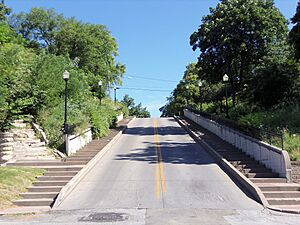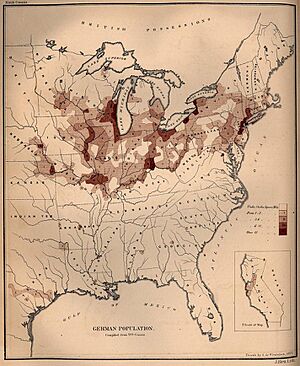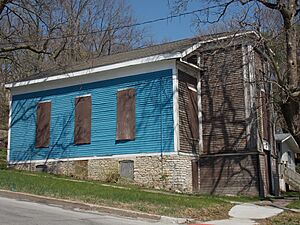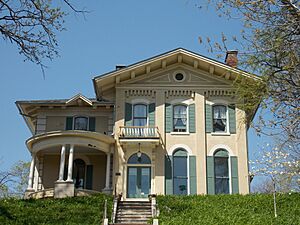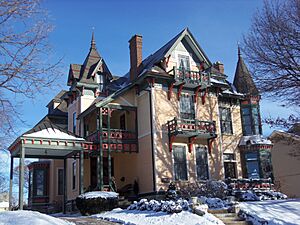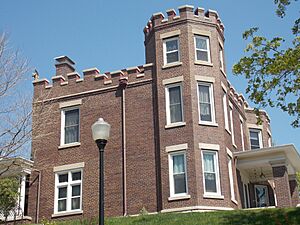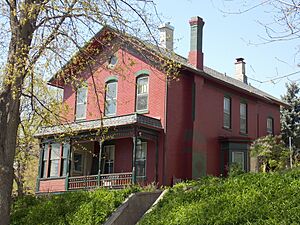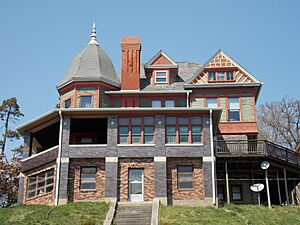Hamburg Historic District (Davenport, Iowa) facts for kids
|
Hamburg Historic District
|
|
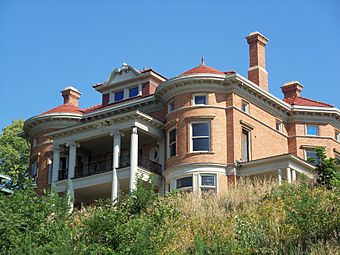
Overview
|
|
| Location | Roughly bounded by 5th, Vine, Ripley, and 9½ Streets, Davenport, Iowa |
|---|---|
| Area | 106 acres (43 ha) |
| Architect | Benjamin Aufderheide Frederick G. Clausen Gustav A. Hanssen Deidrich J. Harfst Thomas McClelland et. al. |
| Architectural style | Late Victorian |
| MPS | Davenport MRA |
| NRHP reference No. | 83003656 (original) 100000541 (increase) |
Quick facts for kids Significant dates |
|
| Added to NRHP | November 18, 1983 |
| Boundary increase | January 17, 2017 |
The Hamburg Historic District is a neighborhood in Davenport, Iowa, United States. It sits on a hill northwest of the city center. This historic area is listed on both the Davenport Register of Historic Properties and the National Register of Historic Places. It was once home to many German families who moved to Davenport in the 1800s. Germans were the largest group of immigrants to settle in Davenport during that time.
Contents
Exploring the Hamburg Historic District
The Hamburg Historic District is found northwest of downtown Davenport. Its main part is between Fifth and Ninth Streets (south to north) and Ripley and Vine Streets (east to west). This section has the most historic buildings. It also shows some of the best examples of old building styles in the area.
The Mississippi River is just five blocks south of the district. The land gently slopes upward as you go north. Then, after an alley north of Fifth Street, it rises sharply into a bluff. The highest point is around Seventh Street, then it slopes down again to Ninth Street. The southern part of this area offers amazing views of the city and the river. This made it a popular spot for German families to build their homes. The Chicago, Rock Island and Pacific Railroad tracks along Fifth Street also mark a boundary. The north side of Sixth Street, along the bluff, is even known as the "Gold Coast."
A Look Back at History
German immigrants began arriving in Davenport in large numbers in the late 1840s. By 1850, nearly 3,000 Germans lived in the city. This was about 20% of Davenport's total population. German immigration continued strongly through the 1880s. By 1890, a quarter of all residents in Scott County, Iowa were from Germany.
Many of these immigrants came from Schleswig-Holstein. This region was having problems with Denmark in the 1840s. Many Germans from there, who had independent ideas, left their homes. A lot of them chose to come to Davenport. They often had different political and philosophical views. This thinking later shaped Davenport's politics. It made the city unique compared to other Midwest communities. Other German immigrants came from places like Bavaria, Hamburg, and Hanover. A small Hungarian community also lived in these German neighborhoods. They were refugees from a revolution against Austria in the 1840s.
At first, some people born in Davenport were not happy about the large number of Germans. They also disliked the separate German groups, schools, and events. Supporting the Temperance movement, which wanted to ban alcohol, was one way to show anti-German feelings. In 1855, a group called the Know Nothing movement appeared. Their goal was to keep local politics for native-born people. But after the American Civil War, when both German and non-German sons fought together, people started to accept each other more. Even so, more Germans continued to arrive in the city.
Because so many Germans lived in Davenport, their customs influenced the city's economy, culture, and politics. Many German leaders lived in the Hamburg District. Germans with lower incomes often lived closer to the factories along the Mississippi River. These areas were known as the West End. Harrison Street usually divided the German areas to the west from the non-German areas to the east.
German influence in Davenport began to fade in the early 1900s. This was especially true with the start of World War I. The war, along with younger generations feeling less connected to their German roots, led to this decline.
Many important Davenport citizens lived in the Hamburg District. These included Henry Lischer, who ran a German newspaper called Der Demokrat. Merchants August Steffen and his son August lived there, as did F. Max D. Peterson. He was a partner in a big store called J.H.C. Petersen's Sons' Store. Brewers Henry Frahm and Henry Koehler also lived in the district. The Mueller family, who owned a large lumber mill, were residents too. H.H. Andressen, who started the German Savings Bank, also lived here. This bank later became the American Commercial and Savings Bank. Politician Hans Reimer Clausen, grocer Charles Beiderbecke, and financier William H. Weise were also residents. All these men had ties to Schleswig-Holstein. They built impressive homes in the Hamburg District. Many of their children even married into other families from the district.
Architectural Styles
The Hamburg District is on a fairly steep hill north of downtown. On Ripley Street, the sidewalk even turns into steps as it climbs the hill. This area has the most historically important houses in Davenport.
The simple Greek Revival style was one of the first to appear here. These homes are usually found at the bottom of the hill. They often look like small cottages or two-story homes with three sections and a front gable roof.
Other homes in the district include large Victorian houses. These were built in the 1800s in styles like Gothic Revival, Second Empire, Italianate, and Queen Anne. Many of these grand homes sit at the top of the bluff. They offer amazing views of the river valley below. You can also find homes from the early 1900s in the Georgian Revival and American Craftsman styles. The district also has smaller, simpler homes from the late 1800s and early 1900s, plus a few modern buildings.
Today, the Hamburg Historic District is mostly a residential area. Many older public buildings have been torn down or changed into homes. For example, a building on West Seventh Street was once Iowa College. The college moved away in the 1850s. The former German Methodist Episcopal Church is still on West Sixth Street. However, Zion and Trinity Lutheran Churches built new buildings outside the district in the mid-1900s. Many other German community buildings, like civic centers or stores, were built outside the Hamburg District.
Notable Homes in the District
Here is a list of some of the most historically and architecturally important houses in the district. One of these houses is individually listed on the National Register of Historic Places. Five others are listed on the Davenport Register of Historic Properties.
Craftsman Style
- Deidrich J. Harfst House (1905) 424 W. 7th Street
- William H. Korn House (around 1915) 730 W. 8th Street
- Charles E. Meier House (around 1905) 519 W. Eighth Street
Greek Revival Style
- 716 W. 5th Street
- Frank & John Bredow House (around 1876) 822 Gaines Street
- Goettsch House (around 1850) 801 W. 6th Street
- Christian Jipp Home & Grocery (1868) 730-732 Gaines Street
- John G. & Angela Otten House (1864) 906 W. 5th Street
- Emanuel Rothschild House (around 1855) 714 W. 6th Street
- Hans Stoltenberg House (around 1870) 911 W. 7th Street
- Frederick Wunder House (1858) 916 W. 9th Street
Georgian Revival Style
- Henry Koehler House (1896) 817 W. 7th Street
- Dr. Heinrich Matthey House (1900) 505 W. 6th Street
- Christian Mueller House (around 1910) 530 Ripley Street
- August Steffen Jr. House ("Overview"; 1901) 412 W. 6th Street
Gothic Revival Style
- Charles Beiderbecke House (1881) 532 W. 7th Street
- Henry Frahm House (around 1880) 321 W. 6th Street
- Francis Ochs House (around 1870) 729 W. 6th Street
- Henry Christian Struck House (1909) 615 Ripley Street
Italianate Style
- Lambrite-Iles-Petersen House (1856) 510 W. 6th Street
- Henry Lischer House (1871) 624 W. 6th Street
- Petersen-Hanssen House (1878) 629 Brown Street
- August Steffen Sr. House (around 1865) 420 W. 6th Street
- William J. Wiese House (around 1895) 709 Brown Street
McClelland Style
This is a special type of house named after Thomas McClelland. He was a very active builder in Davenport who constructed many of them.
- John Bahls House (1864) 614 W. 5th Street
- Peter Bindschaedel House (1870) 917 W. 8th Street
- Frederick G. Clausen House (around 1865) 630 W. 6th Street
- Henry & Franciska Dohrman House (1868) 630 Warren Street
- Gustav Hageboeck House (1870) 623 W. 6th Street
- Friederich Hartmann House (1868) 604 W. 5th Street
- Charles Hill House (around 1875) 724 W. 8th Street
- Lavinius W. Petersen House (around 1865) 530 Western Avenue
Mission Revival Style
- Louis P. and Clara K. Best Residence and Auto House (1910; listed on the National Register of Historic Places) 627 Ripley Street
Queen Anne Style
- H.H. Andressen House (around 1865, 1885) 726 W. 6th Street
- Carl Beiderbecke House (around 1890) 510 W. 7th Street
- William Hahn - Edward Berger House (1895) 803 W. 7th Street
- William Hoersch House (around 1892) 402 W. 7th Street
- Oscar C. Koehler House (around 1895) 817 W. 7th Street
- Claussen-Mueller House (around 1900) 413 W. 6th Street
- Edward C. Mueller House (around 1895) 429 W. 6th Street
- Louis Naeckle House (around 1895) 703 Ripley Street
- Herman Schmidt House (around 1895) 525 W. 9th Street
- George Schriebel House (around 1855) 732 W. 5th Street
- J.O. Seiffert House - A. J. Hirschel House (around 1890) 532 W. 6th Street
- J.C. Struck House (around 1896) 703 Ripley Street
- Hennings Witt House (1894) 604 Gaines Street
Second Empire Style
- Henry Frahm House (around 1880) 321 W. 6th Street




